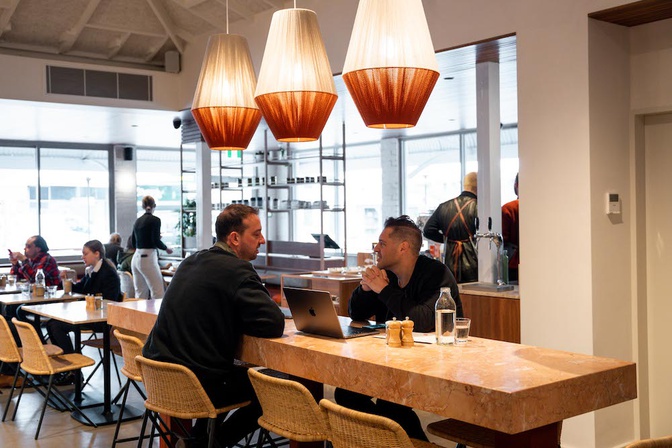Working from a cafe or restaurant is becoming commonplace.

Sitting down with your laptop to finish some work in a cafe isn’t a new concept. But in a post-Covid world and with hybrid working arrangements becoming the norm, working from a cafe is increasing in popularity.
Dubbed “Working from Hospo” by hybrid workers (those working from a cafe, a restaurant or a hotel), employees spend their day away from home or the office. Workers feel it is a more productive form of hybrid working, being able to work individually and efficiently.
Results from a 2020 Hassle survey found 41 per cent of Australians were working in a hybrid situation, with 29 per cent of workers entirely at home.
The survey also found the most popular workplace scenario was one where a worker has the flexibility to work from home or another space when needed.
This is still true in 2023. Many workers are logging in from their home or a third space and are getting the same, if not more work done compared to if they were in the office.
A Swinburne University January 2023 study found working from a hospitality area is becoming increasingly popular and will become the “new normal” throughout the year.
Swinburne’s research has also shown that cafes were the clear winner when it came to a third working space – more popular than co-working spaces. Other favourites include pubs, libraries and parks.
Researchers found workers frequent hospitality spaces to work two to three times per week and spend around $4 to $30 each visit. This is good news for Australian hospitality venues, which have been struggling with high inflation rates, staffing shortages and the cost of living crisis.
Lead researcher and Swinburne Innovation Fellow John Hopkins identified four third-place workers in his study. “‘Device Disconnectors’ like to visit third places for a quick break away from technology, ‘Caffeine Creatives’ use the change of environment as a mental reset to help them think creatively,” Hopkins said in the study.
“‘Suburban Socialites’ like to counteract the threat of loneliness when working from home with short regular visits to their local third place, and ‘Lunchtime Liaisons’ use third places for regular meetings with clients or colleagues, often combining this with lunch or breakfast.”
The research also found third-space workers have three main priorities when choosing a space – a venue having good reviews, feeling welcome to work and having access to wi-fi and power sockets.
“Venues looking to attract these types of workers might have signage welcoming people to work within, provide a dedicated working space, advertise the wi-fi password or offer special bundles, such as a two-hour package including unlimited coffee and a sandwich,” Hopkins said in the study.
With hospo venues having to adapt rapidly to changes during the last few years – as well as rising operating costs – changing tact to allow for an increased demand to work from hospo might not be high on the agenda. But with the agility Australian cafes and restaurants have shown in recent times, don’t be surprised if your local adopts some subtle co-working features in the near future.
Photography: Liana Hardy



